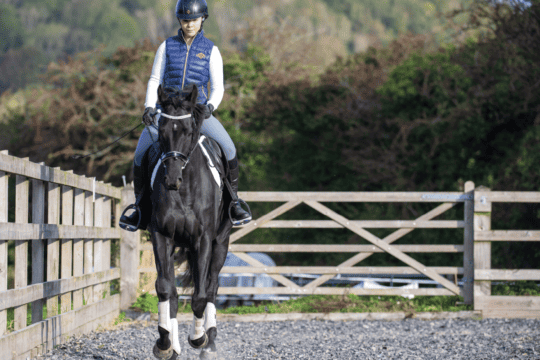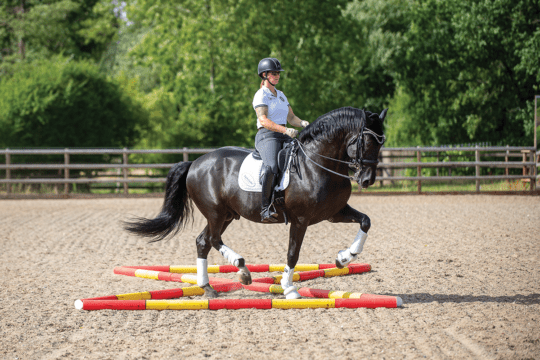You’re ready to start improving his flatwork, but what’s most important to begin with? Clare Poole, top ex-racehorse producer, explains
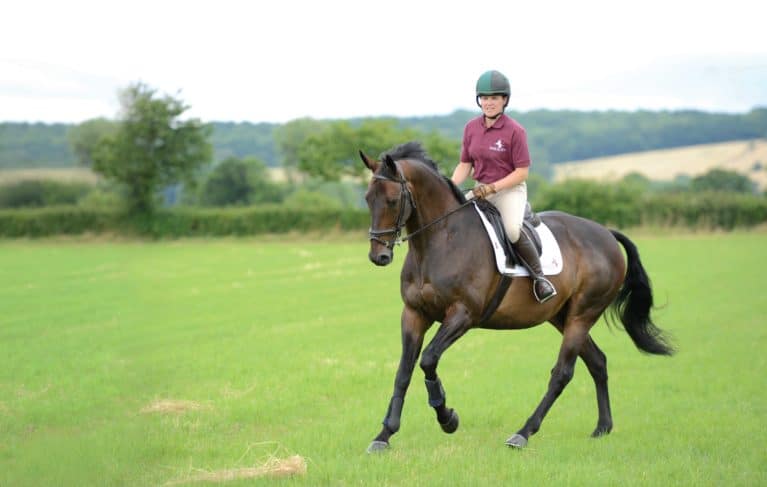
Introducing flatwork and all the leg aids that come with it can be a daunting prospect if your horse has only ever been trained to gallop. But knowing where to start and approaching it in the right way will set you on the path to success.
To begin with, don’t worry about the picture as a whole, but focus on one thing at a time. Remember that, although your horse may be older, he won’t have the education or musculature of a riding horse of a similar age, so you need to approach him like you would a newly backed four-year-old. Along with encouraging him to stretch rather than trying to hold him in an outline – this will really help him to relax, which will allow you to do the same – your priorities are equalling the bend on each side, improving his balance and sharpening up his transitions.
Top tip – If you’re asking your horse for something but he says he’d rather canter, for example, try not to get into an argument. Leave it, do something else and come back to it. Sometimes it’s useful to approach the same question in a different way.
Sharpen up your transitions
It’s important for your safety, as well as good for your marks in a show ring or dressage test, that your horse responds quickly and accurately when you ask him for a transition. Transitions aren’t new to an ex-racer as he’s obviously able to move between paces, but this is a whole new way of doing it for him. Rather than changing up and down a lot, he’ll be used to maintaining one pace for a length of time, so you need to mix it up for him. Avoid making too much of each transition – for example, when you’re introducing canter, try to make the transition into canter almost without him realising. Approach it like you would with a youngster who’s cantering for the first time – at this stage it’s all about getting into the pace rather than how you get there. Don’t worry if he runs into canter or strikes off on the wrong leg at first, you can work on that later.
It’s useful to introduce halt to canter and canter to halt quite early, even if you have a few steps of trot in-between to begin with. I find it really helps to get horses listening. Introducing rein-back will also remind him to listen to you, and to be less forward and strong. It makes him think about what you’re asking, rather than you getting into a battle with him.
Exercise 1 – Transitions square
Lay four poles out in a square. Ride across the square in walk and halt in the middle, before riding out the other side. You’ll need to prepare for your transition before you meet the first pole.
Step it up
- As your horse improves, there are a number of ways to increase the difficulty and sharpen up your transitions further. You could…
- ride to the square in trot and ask for a halt transition inside the square
- try halting with his front legs over the pole and his hindlegs behind the pole
- close up the corners and make the square smaller
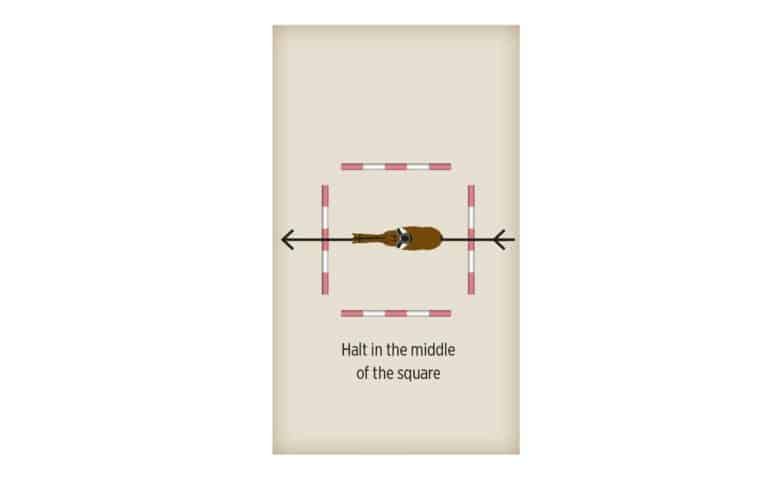
Top tip – When riding a downwards transition, I find ex-racers come back to you quicker if you gradually let the reins slip through your hands, rather than maintaining the same contact. If you maintain too much contact he’s likely to try to pull away.
Top tip – Ex-racers are used to working in a fairly open space rather than being restricted to an arena. So, although you might feel more nervous about asking for a canter transition in the open, your horse will feel less confined and more relaxed.
Top tip – Before you try exercises with poles, introduce your horse to a single pole on the ground first because, although he may have raced over jumps, it’s unlikely that he’s ever come across a pole.
Did you know? Polework is a great addition to your flatwork because it gives your horse something else to think about.
On the straight and narrow
For your horse, being able to move straight – really straight – is harder than you think, especially if he’s not used to it. It’s important that he uses each side of his body equally.
Exercise 2 – Corridor
Place two poles approximately one metre apart to create a corridor. Ride through at walk, keeping your leg aids even and your horse as straight as possible.
Step it up
There are a few things you can do to make it more of a challenge…
- make the corridor narrower
- ride through in trot and canter
- make the corridor longer
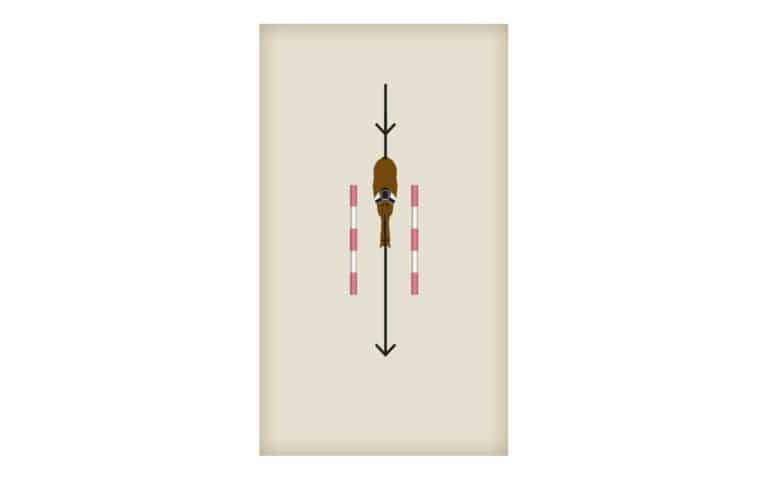
Top tip – Corridors are really good for practising straight halts and rein-backs, too.
Create equal bend
When he was in training, your horse wouldn’t have needed to use his ability to bend much at all – sprints are run on the straight and longer races are run on long, sweeping tracks. Most ex-racers had a preferred direction to race in and may have been exercised in the same direction every day, so are unlikely to be equally supple on each side, either. There are quite a few exercises you can do that will help to improve your horse’s bend – these are two of my favourites…
Top tip – Make sure that your inward spiral is equal in rhythm and length to your outward spiral.
Exercise 3 – Spirals
Begin walking on a large circle that’s approximately 20 metres. Once your horse is balanced, ask him to make the circle smaller over the course of a few laps by opening your inside rein. Use your outside leg to move his shoulders over, but keep your inside leg on the girth to stop him falling in. Spiral in until you’re riding a 15-metre circle, then begin spiralling out. Think straight first, then open your outside rein. Put your inside leg on the girth to push your horse out and maintain a steady contact with the inside rein.
Step it up
When your horse can do the spiral in good balance, you can…
- spiral in further to a smaller circle
- ride it in trot and, eventually, canter
- Doing spirals properly is quite hard for your horse, but if he can do them in all paces, with a uniform bend, you’re doing really well.
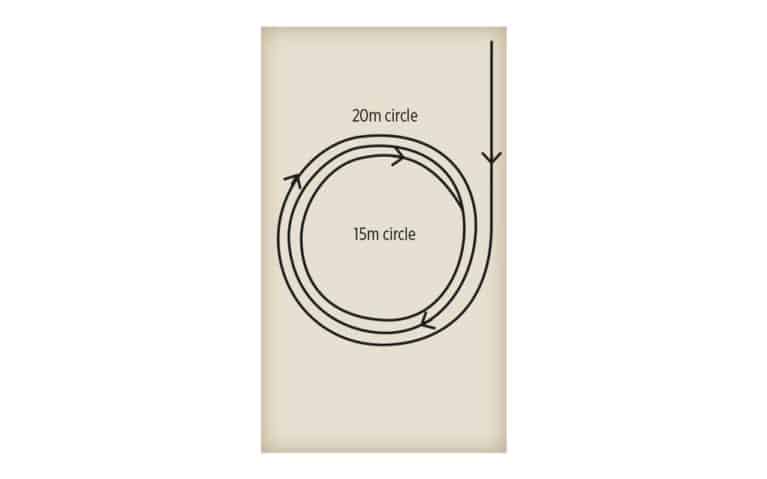
Exercise 4 – Corners
Use the same square that you laid out in exercise 1. Ride in and out of the square, using the poles to create corners. Think of riding each turn like a turn on the forehand and use the poles to help you. Do a couple of turns, then walk away from the square and come back to it so that you’re not riding multiple tight turns in succession.
Step it up
When your horse is more advanced, you can…
- make a turn on every corner
- try the exercise in trot
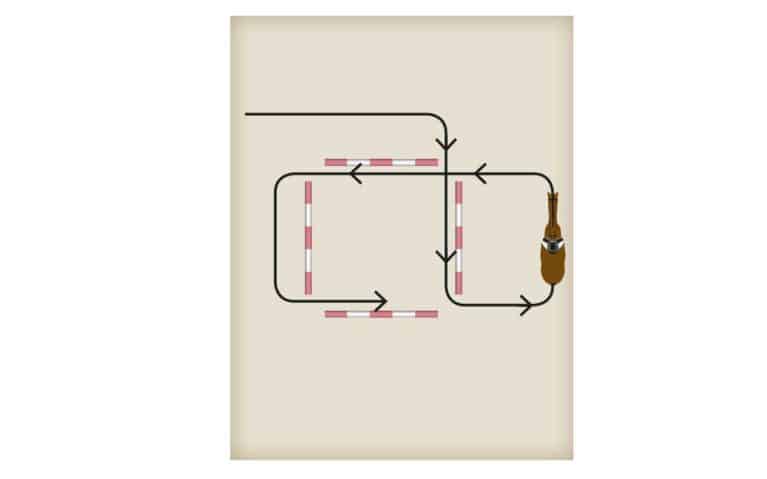
Top tip – If you’re planning to show your horse, practising riding loops is a great way to prepare for overtaking in the ring.
Did you know? If your horse is naturally downhill or on his forehand, short bursts of canter, lots of transitions, lateral work and stretching will all help him to shift his weight back and balance from behind.
Accepting the contact
Working in an outline is a whole new concept to an ex-racehorse, so you’ll have to be prepared to think outside the box. Many of them don’t have a sensitive mouth, not in the sense that they’re hardened, but that they don’t understand the finer aids you might be used to, so you’ll need to focus on your seat aids and do even less with your hands.
As soon as your horse is able to relax his frame and is equally supple on each side, you can progress to asking for contact and togetherness.
Top tip – Avoid using side reins or draw reins, as your horse is likely to try to pull away.
Happy hacking
As with all horses, some ex-racers are better at hacking than others. You’ve got to remember that, although some will have been out a lot, it will have been in a string on their way to the gallops, which is quite exciting and doesn’t involve much thinking for themselves like normal hacking does. I like to hack my horses, but find that some go better alone, and all of them are best in no more than pairs. If you have more than two you’re replicating the old situation of a string and they’ll always want to be a nose in front of the other horses.
As a racehorse, it’s likely that he’s seen a lot and is more worldly than most. This can help in some situations, but I find in some situations or competition venues the adrenalin can kick in and make things more difficult for you – it all depends on your horse.
Top tip – When choosing a bit, I find that ones with cheeks help with straightness and bend.
Time to move over?
When you’re ready to try introducing lateral work, it can seem logical to begin in walk. However, I find that ex-racehorses sometimes find lateral movements harder when they don’t have any forward momentum, especially at first. They’re forward-thinking horses so, while they’re trying to learn something new, avoid stifling their pace or working in a small space.
Putting it all together
When your horse has started to improve in each area, his musculature will begin to change and develop. Avoid rushing him because such a change will take time. Keep his work varied and interesting, with lots of different ways to achieve the same end goal. Many ex-racers have naturally good self-carriage and are very athletic, so take to flatwork really rather well.
Web extra – Find out how Clare approaches her favourite flatwork exercises: bit.ly/Clare_Flatwork




